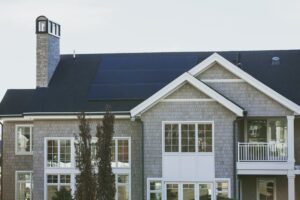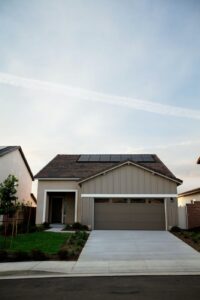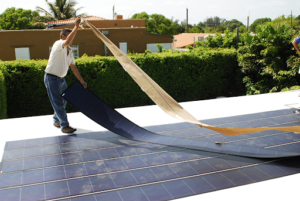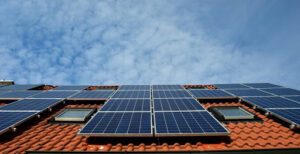5 Ways to Make Solar Not Hideous
Houses with higher curb appeal sell for as much as 7% more than comparable houses with lower curb appeal. But California is pushing solar panels on every roof–and solar panels are often an eyesore.
Fortunately, there are ways to make solar installations less hideous. And when done well, homes with solar sell about 20% faster than homes without, and add an average of $18,000 to a home’s value.
So how do you add solar to your home in a way that improves its value?
There are many different options, depending on the look you’re going for. If you’re going futuristic, it’s fairly easy. If you’re trying to maintain your rustic vibe, it’s harder—it’s difficult to integrate the clean-cut, black solar panels into an older-style home. You might also consider a ground mount over a roof mount to avoid the issue entirely. But here are some general tips.
Decide what color solar panels you’d like.
Monocrystalline solar panels are darker and generally look nicer; black panels with black backing and no wires are considered the most attractive. They’re more expensive, but more energy-efficient.
Polycrystalline panels, which typically come with silver frames and white backing, are less attractive; they are bluer and less sophisticated. While polycrystalline panels are less energy-efficient than monocrystalline, they are also less expensive.
If both monocrystalline and polycrystalline panels are options for your wallet, you may also consider how their colors contrast with your roof’s color.
Consider the contrast of colors.
Black solar panels on a dark brown roof are generally a no-no. Black on black is okay, if the shades match. Grey or grey-blue and black are good. The most ideal roof color for black solar panels is a lighter color, because they’re far enough from black to be complimentary.
The bluer solar panels, while less professional-looking overall, are easier to match to your roof; blue looks okay on any background.
Consider redoing your roof.
Obviously, this makes the most sense if your roof isn’t strong enough to support solar panels in the first place, but it also has an aesthetic component. Solar panels are beautiful and sharply cut, but if your roof contrasts that by being worn-down, it decreases the curb appeal.
Plus, if your roof is worn-down and within ten years of being replaced anyways, it’s recommended that you replace it before installing solar panels. Even if you’re pretty sure your roof is fine, you should plan a roof inspection before installing solar panels; it’s a pain to have to remove solar panels just for a roof repair. In the long run, replacing (or at least, repairing) your roof before installing solar panels saves you time and money.
Additionally, if you’re worried about energy, you might consider putting in a cool roof. They save you up to 40% on cooling costs (Green Building Alliance), which comes out to over $100 annually.
Decide on a mounting system for your solar panels.
There are essentially two options: normal, bulkier mounting systems, or adapted, slimmer mounting systems.
These slimmer solar panels are called “thin film”, or “railless mounted solar.” Thin film solar panels are less than 1% the thickness of typical silicon solar cells, so they sit flatter against your roof.
Image by Fieldsken Ken Fields
And where typical solar panels require six or seven extra inches between the roof and the panel for a rail, railless mounted solar allows the panels to be mounted almost directly on the roof.
There are even some solar panels which are mounted directly into the roof. The section of roof below it is removed, and the panel is installed.
Some solar panels rotate to face the sun as it passes overhead. Unfortunately, most of these slimmer solar panels don’t have that option. They can still be installed at the optimal location on your roof to maximize energy output, but their efficiency won’t be quite as high as that of rotating panels.
Slim mounting systems give your home a sleeker look, which is better for more modern homes. Older-style homes pull off the bulkier, more classic mounting systems. But ultimately, the choice between the two is made between you, your solar installation company, and your bank account.
Place all the solar panels next to each other, if possible.
Placing them farther apart gives a disjointed, disorganized look. In some cases, you may have to build around skylights or other roof features, but in general, the more panels you put next to one another, the more professional your roof looks.
There are also some administrative advantages to installing panels all close to one another. Running the wiring through all of the panels is easier when they’re closer, for example. And once solar installers have found the place on your roof that receives the most sunlight, they’ll want to maximize the number of solar panels they put there.
Solar installers recommend locations on your roof to install the panels, and they tend to place the panels all next to each other. But just in case they don’t, it’s something you should also consider aesthetically.
Bonus 1
The Tesla Solar Roof checks a lot of these boxes. It replaces your entire roof with slate-like tiles, some of which are solar panels in disguise. It insets the panels into the roof for a sleeker look, and the solar panels blend right into the roof tiles, so you don’t need to worry about putting all the solar panels next to each other. The Tesla Solar Roof is the epitome of a modern-style solar roof.
Check it out here: https://www.tesla.com/solarroof
Bonus 2
Sistine Solar has a solar panel skin that covers the panels and makes them look like the roof around it. The skin filters the light so that almost all of it still passes through the solar panel, but uses some of the light to project any predetermined roof color and texture. This is perfect for any roof type, and comes at a reasonable price.
Check it out here: https://news.energysage.com/sistine-solar-customized-solar-skins-solar-panel-system/
And here: https://www.sistinesolar.com/technology
Bonus 3
Several off-the-wall solar companies offer many different colors of solar panels. If the classic black or blue isn’t working for you or your roof, you could try a light yellow, a white, or maybe a purple.
Check it out here: https://www.coloredsolar.com/Products.html (available across the U.S.)
And here: https://nakedsolar.co.uk/solar-pv/solar-panel-aesthetics/
So if you’re worried about the curb appeal of your home decreasing after installing solar panels, don’t be; there are many different routes available to increase the value of your home and make it easier to sell.
References
https://stellarsolar.net/2018/02/20/aesthetically-pleasing-solar-panels-style-guide/
https://news.energysage.com/sistine-solar-customized-solar-skins-solar-panel-system/





